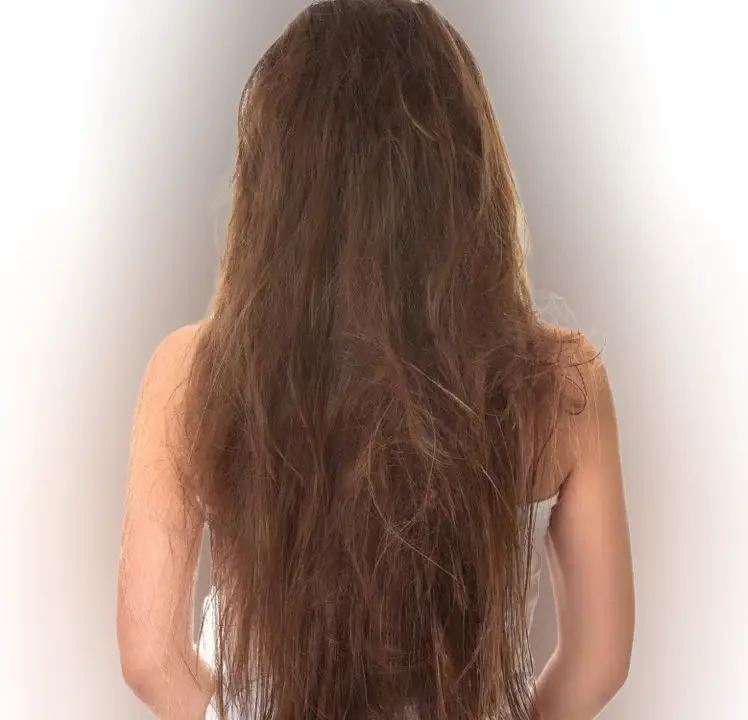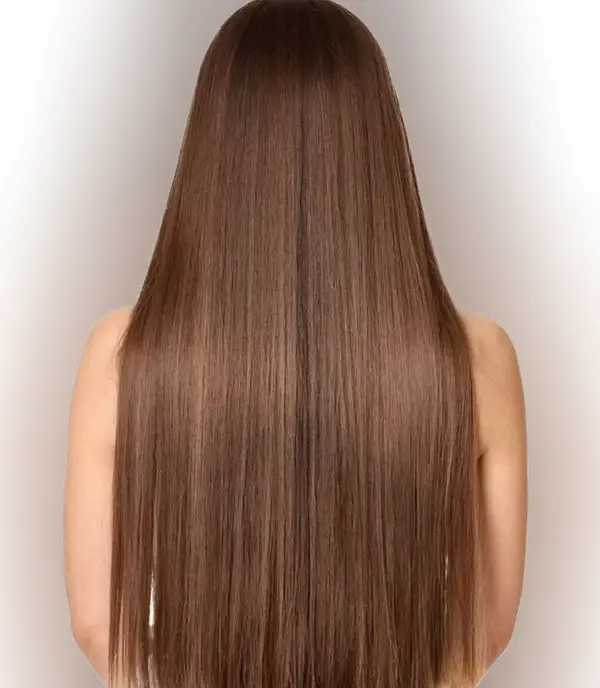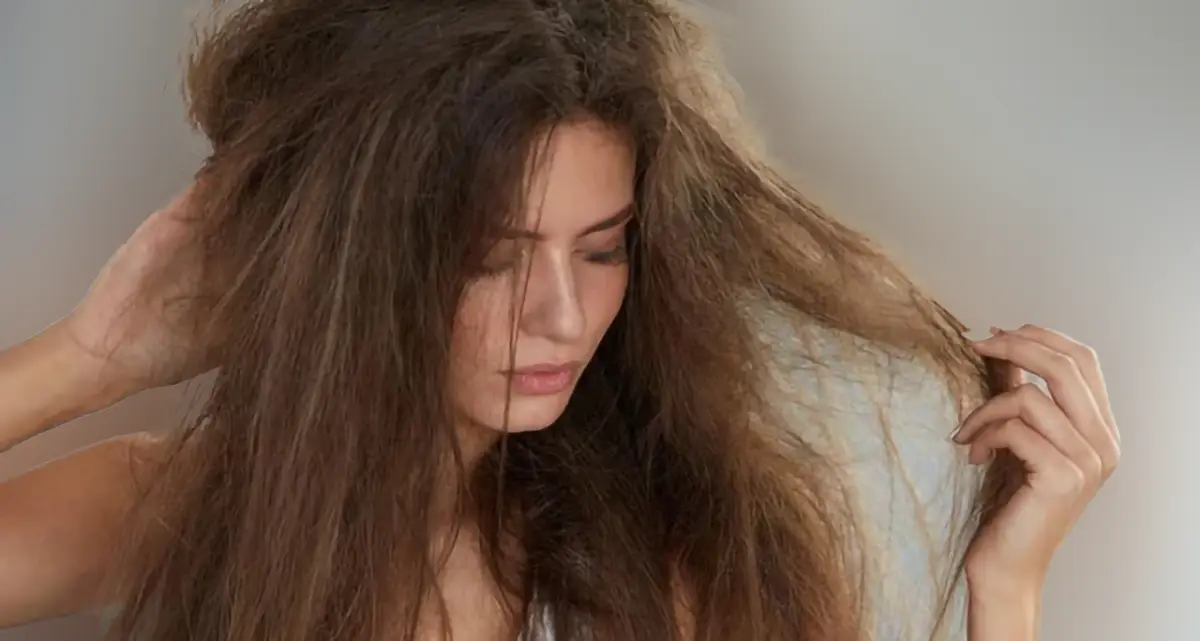If your hair feels dry, brittle, or full of split ends, it may be time to give it some serious TLC. Excessive heat styling, dyeing, and bleaching can leave your hair damaged and lifeless, but how to repair damaged hair? there are simple haircare tips to help restore it to a healthier-looking state.
Start by using a gentle shampoo designed for damaged hair and avoid washing too often, as that can strip away natural oils. Focus on repairing your hair with moisturizing products and treatments that address breakage and dryness. Incorporating these changes into your routine will give your hair the strength it needs to bounce back.
How Can You Tell if Hair is Damaged?
Damaged hair shows several clear signs, like split ends, constant flyaways, and a dry, brittle texture that feels rough when touched. You may notice breakage and strands that shed more than usual, especially when brushing. The dull appearance and frizzy look make it hard to style, and your hair tends to tangle easily.
If your hair thins or you spot bald patches, that’s a severe indicator of damage. The American Academy of Dermatology (AAD) suggests checking for changes in texture or curl pattern—whether you have straight, coarse, curly, or coily hair—if your once defined curls turn into looser ringlets or your straight hair feels more fragile, it’s time to adjust your haircare routine.
Is It Possible to Repair Damaged Hair?
While damaged hair can’t be fully restored to its original state, you can improve its condition and reduce the appearance of split ends and broken strands. Damage caused by heat, chemical treatments like dye, relaxers, or bleaching, and even mechanical factors like rough handling, excessive brushing, or tight hairstyles can be managed.
Start by limiting the use of styling tools and adopt a gentler haircare routine to protect your hair. Regular trims to cut away damaged ends and using high-quality products can help your hair look healthier over time.
What Causes Hair Damage?

There are several causes and factors, but we discuss here three of the most common causes of hair damage.
1. Bleach
Bleach can cause significant damage to your hair by breaking down its natural structure. The chemical process of bleaching disrupts the disulfide bonds within the hair, which are crucial for maintaining strength and elasticity. This breakdown can lead to breakage, split ends, and dryness, leaving your hair feeling broken and fragile.
Along with hydrogen and salt bonds, the disulfide bonds are weakened during chemical services like perming and bleaching, which makes hair more prone to breakage. Regular bleaching can severely affect hair’s overall health, leading to long-term damage if not carefully managed.
2. Hair color
Using permanent hair color can cause damage over time, leaving your strands feeling dry and brittle. The AAD points out that frequent coloring, especially when lightening your hair with bleach, leads to significant dehydration and makes your hair prone to breakage.
Opting for a darker shade can be a less damaging alternative, while still achieving a stunning look. Keeping this in mind can help reduce the impact of coloring on your hair’s health, and finding the right inspo can help you choose styles that are gentler on your locks.
3. Heat styling
Using hot tools to achieve trendy styles like a voluminous blowout can seriously damage your hair if done frequently. High temperatures can fry your strands, leading to breakage and dryness. To prevent heat damage, practice styling in moderation and follow healthy hair care practices.
Always apply a heat protectant before using any hot tool and keep the temperature setting as low as possible for your hair type. Styling in smaller sections can also minimize damage while still letting you achieve your desired style.
How to Care for Damaged Hair?
To revive damaged hair, using the right bond-repairing products is key. A system like EverPure Bond Repair can help strengthen the hair from the inside by targeting weakened bonds. This system includes a Pre-Shampoo Treatment, Sulfate-Free Shampoo, and a Citric Acid Conditioner, all working together to repair the cortex structure of your hair.
These products not only smooth and help with detangling, but they also work to prevent future damage. Using this collection on damp hair while lathering and conditioning will leave your hair smoother, stronger, and ready to reinvigorate your mane.
11 Tips to Manage and Protect Damaged Hair

Contrary to popular belief, there are several ways to manage current damage and prevent future breakage without chopping off your locks. Here are 11 tips for caring for damaged hair—only one of which involves losing any length.
1. Choose the Right Shampoo and Conditioner for Damaged Hair
To keep hair healthy, using a haircare system specifically formulated for damaged hair is essential. L’Oréal Paris EverPure offers bond-repairing products that can help strengthen and revive brittle strands.
These shampoos and conditioners deliver the benefits of bonding treatments by repairing and protecting your hair from further damage. Incorporating this into your routine ensures that your hair receives the right care to become stronger and healthier over time.
2. Wash your hair with lukewarm water
Washing your hair with hot or steamy showers may feel indulgent, but the heat can harm damaged strands. Hot water can strip your hair of essential oils, making it drier and more prone to breakage. Instead, use lukewarm water to wash and rinse your hair.
This gentle temperature helps keep moisture locked in while also preventing color from fading. By making this simple switch, you can improve the overall health of your hair while still enjoying a nice shower.
3. Use a deep conditioning treatment
Adding a deep conditioner to your haircare routine is essential for repairing damage and combating dryness. Using conditioning treatments at least once a week can help reduce split ends and breakage. Look for products with nourishing ingredients like proteins, collagen, and peptides that work to strengthen your hair.
These treatments provide extra hydration, making your hair feel softer and more manageable. By regularly using a deep conditioner, you’ll be protecting your hair from future damage while enhancing its overall health.
4. Apply leave-in conditioner
Applying a leave-in conditioner after washing your hair can work wonders to reduce frizz and minimize the appearance of split ends. This extra step helps prevent damage and leaves your hair feeling softer and more manageable.
Products like L’Oréal Paris Elvive Total Repair Protein Recharge Treatment offer a lightweight, creamy formula that smooths out damaged hair without weighing it down. For those with curls, the Dream Lengths line provides added moisture and helps keep your curls looking bouncy while also acting as a heat protectant during styling.
5. Dry your hair with a T-shirt
Instead of rubbing your hair dry with a rough terry cloth towel, try using an old, faded T-shirt as a gentler alternative. After you plop your hair in the shower, the soft cotton fabric helps to quickly absorb excess water without causing breakage. This caring method reduces pulling and is much more gentle on your hair, keeping it healthy and less prone to damage.
If you have extra faded T-shirts, consider repurposing them for this purpose, or you can opt for a microfiber cloth designed for hair drying, as it’s also soft and absorbent.
6. Be Gentle with Your Brush
To keep your hair looking smooth and soft, it’s important to avoid over-brushing. Frequent brushing can create friction that weakens the outer layer of your hair, making it more likely to break. Instead of using a regular brush, try a gentle, wide-tooth comb to tackle tangles with ease.
When brushing, use soft strokes, especially when you first get out of bed. This gentle approach will help you do the job without causing unnecessary damage to your precious locks, keeping them healthier and stronger.
7. Ditch the Hairbrush for a Wide-Tooth Comb
Switching from a hairbrush to a wide-tooth comb can greatly help protect your damaged hair. When your hair is wet, it becomes more fragile and susceptible to breakage, making it essential to handle it with care. A wide-tooth comb has larger spaces between its teeth, which helps to smooth and detangle without tugging.
This gentle method reduces friction and the risk of tangles that can cause damage. For extra benefits, you can apply a nourishing detangler like L’Oréal Paris EverPure 21-in-1 Color Caring Spray before combing. This way, you can enjoy smoother strands while protecting your hair from knots and breakage.
8. Always use a heat protectant
Using a heat protectant is an important step to protect your hair before styling. Whether you’re going for voluminous curls or a sleek blowout, applying a product like L’Oréal Paris EverPure Sulfate-Free Weightless Blow Dry Primer or Elvive Dream Lengths Frizz Killer Serum helps shield your strands from the damage that high heat can cause.
This step is crucial, especially if your hair shows signs of being dry or fragile. By protecting your wet hair before you style, you not only help to tame frizz and static but also maintain healthier-looking hair over time. So, make it a habit to always apply a heat protectant first!
9. Give heatless hairstyles a try
Trying heatless hairstyles is a great way to protect your damaged hair while still looking stylish. By avoiding hot tools, you can keep your mane healthier and prevent further break. Embracing your natural texture can be a game-changer!
You can enhance your curls by using a curl-defining leave-in treatment and scrunching your hair to bring out its natural pattern and volume. For a quick style, try low ponytails or messy buns. If you want beachy waves, experiment by braiding your hair overnight. This way, you get stunning styles without the risk of heat damage!
10. Choose a Silk or Satin Pillowcase
Sleeping on a silk or satin pillowcase is a smart way to protect your damaged hair. Unlike cotton, which can create friction and cause tugging, the soft, silky touch of these fabrics helps to reduce tangles and frizz.
This gentler option prevents breakage and keeps your hair looking smooth when you wake up. By choosing a silk or satin pillowcase, you can avoid the usual snag that rougher fabrics can cause, helping your hair stay healthy while you sleep!
11. Get a haircut
Getting a haircut is a great way to give your damaged hair a fresh start. If you notice split ends or severe breakage, this moment is the perfect opportunity to remove the damaged strands and switch to a new style. Whether you choose a gorgeous bob, a messy lob, or a cropped look, this technique can help target the dry areas and preserve the health of your hair.
Plus, regular trims can prevent damage from creeping back in, making your haircare routine much easier. Experimenting with short styles can be fun and can help you fall in love with your new signature hairstyle while aiming to grow out your locks.
How Do I Fix Extremely Damaged Hair?
To fix extremely damaged hair, you need to be careful about how you handle your mane. First, it’s important to limit heat styling and avoid coloring or bleaching your hair, as these can worsen the damage. Instead, wash your hair just two times a week to prevent overwashing, which leads to dryness.
Incorporate a protein treatment into your routine to help strengthen your hair and give it a healthy-looking shine. A product like L’Oréal Paris Elvive Total Repair Power Restore Multi-Use Treatment can be a versatile option to boost moisture and fuel strength.
Using a co-wash can also be beneficial, as it helps maintain the balance of your hair while providing a silky feel. By making these small changes, you can enhance your hair’s resistance to future damage.
FAQs About How to Repair Damaged Hair:
Yes, damaged hair can be improved with the right care and products. If you have severely damaged hair from chemical treatments, it’s essential to use bond-building products that help rebuild the keratin in your hair. These products often contain amino acids that work to restore the natural structure of your hair, reducing split ends and breakage. While it may take time and consistent care, you can see a noticeable difference in the quality of your hair, allowing it to become healthier and stronger over time.
Damaged hair can be repaired, but it may not return to its normal state if the damage is severe or permanently altered. To help your hair, focus on using products that strengthen protein bonds and smooth the cuticles. This can prevent further damage while encouraging healthy growth. If the damage is too extreme, you might need to cut your hair to start fresh. With consistent care and the right solutions, you can improve the appearance and health of your hair over time.
Using plant-based oils can indeed help repair damaged hair. These oils work by penetrating the hair shaft, which helps to improve overall hair quality. They add much-needed moisture, helping to overcome issues like dryness and brittleness. Additionally, they can promote growth and even reduce hair loss. Incorporating the right oils into your haircare routine can make a significant difference in restoring your hair’s health and shine.
When looking for the best oil for your hair, coconut oil is a top choice because it softens hair and increases shine. Jojoba oil is great as it moisturizes and adds nutrients to your locks. Geranium oil helps to strengthen the hair and stimulates the scalp, while lavender oil not only deep conditions but also keeps your hair shiny and helps control dandruff. Using these oils can make your hair look healthier and more vibrant.


1 thought on “How to repair damaged hair?”